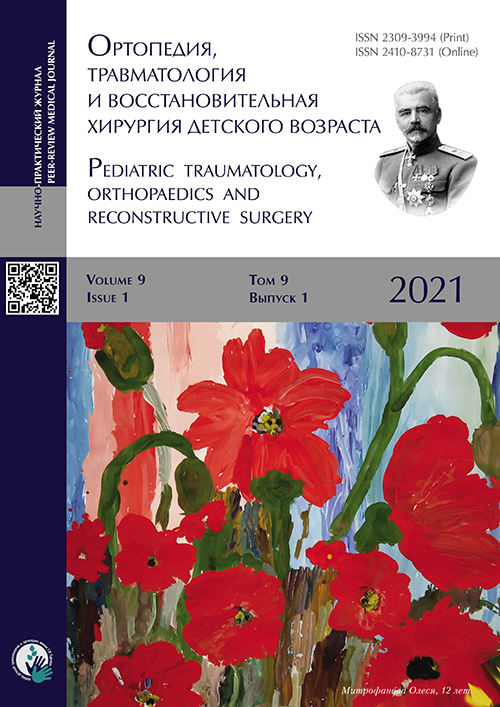Features of free skin grafting to correct post-burn neck deformities in children
- Authors: Filippova O.V.1, Afonichev K.A.1
-
Affiliations:
- H. Turner National Medical Research Center for Сhildren’s Orthopedics and Trauma Surgery
- Issue: Vol 9, No 1 (2021)
- Pages: 77-86
- Section: Exchange of experience
- Submitted: 03.08.2020
- Accepted: 19.01.2021
- Published: 15.03.2021
- URL: https://journals.eco-vector.com/turner/article/view/41937
- DOI: https://doi.org/10.17816/PTORS41937
- ID: 41937
Cite item
Abstract
BACKGROUND: In the literature, various methods of reconstructive plastic surgery for neck cicatricial contractures, from free skin grafting to expander dermotension and microsurgical tissue complex autotransplantation, are widely covered. However, very little attention has been paid to conservative measures aimed at stabilizing surgical treatment results.
AIM: This study aims to evaluate the long-term results of free skin grafting of neck granulating wounds after burns and secondary relapsing scar contracture correction. The study also aims to analyze the causes of poor results and demonstrate the possibility of using free skin grafting to correct neck contractures with basic preventive measures.
MATERIALS AND METHODS: Forty-six patients with neck burn cicatricial sequelae were treated at the clinic of trauma sequelae in H. Turner National Medical Research Center from 2017 to 2019. The patients were divided into two groups: group 1 patients with neck contractures after plasty of granulating wounds with free skin autografts, and group 2 patients with a relapse of neck contracture after corrective reconstructive surgery.
Anamnestic data analysis enabled establishing the actual volume of preventive rehabilitation measures in both patient groups. The classification by N.E. Povstyany (1973) was used to determine the severity of contracture.
RESULTS: The most severe neck contractures, grade III and IV, developed in group 1 patients (grade III — 41.2%). In group 2 patients, there was a limitation of neck extension, corresponding to grades I (33.3%) and II (58.3%).
Conservative preventive measures as immobilization and compression therapy were absent in group 1 in 100% of cases. The most common preventive measure was the prescription of topical anti-scar drugs.
Two-stage skin grafting with full-thickness skin autografts combined with conservative measures made it possible to correct neck contractures of grade I-IV completely and obtain good aesthetic results.
CONCLUSION: The main reason for neck contractures development is the retraction of skin autografts, which inevitably develops in the absence of appropriate preventive measures.
Correction of neck contractures using free skin grafting combined with preventive immobilization using a Schantz collar and a compression half-mask allows obtaining good functional and aesthetic results.
Full Text
About the authors
Olga V. Filippova
H. Turner National Medical Research Center for Сhildren’s Orthopedics and Trauma Surgery
Author for correspondence.
Email: olgafil-@mail.ru
ORCID iD: 0000-0002-1002-0959
SPIN-code: 8055-4840
http://www.rosturner.ru/kl7.htm
MD, PhD, D.Sc.
Russian Federation, 64-68 Parkovaya str., Pushkin, 196603, Saint PetersburgKonstantin A. Afonichev
H. Turner National Medical Research Center for Сhildren’s Orthopedics and Trauma Surgery
Email: afonichev@list.ru
ORCID iD: 0000-0002-6460-2567
SPIN-code: 5965-6506
MD, PhD, D.Sc.
Russian Federation, 64-68 Parkovaya str., Pushkin, 196603, Saint PetersburgReferences
- Gnipov PA, Baindurashvili AG, Brazol’ MA, et al. Preimushchestva rannego hirurgicheskogo lecheniya glubokih ozhogov shei u detej. Ortopediya, travmatologiya I vosstanovitel’naya hirurgiya detskogo vozrasta. 2020;8(1):25–34. doi: 10.17816/PTORS16298. (In Russ.)
- Saaiq M, Zaib S, Ahmad S. The menace of post-burn contractures: a developing country’s perspective. Ann Burns Fire Disasters. 2012;25(3):152–158.
- Mody NB, Bankar SS, Patil A. Post burn contracture neck: clinical profile and management. J Clin Diagn Res. 2014;8(10):NC12-7. doi: 10.7860/JCDR/2014/10187.5004
- Kurbanov UA, Davlatov AA, Dzhanobilova SM, Holov ShI. Hirurgicheskoe lechenie posleozhogovyh rubcov lica s kontrakturoj perioral'noj oblasti. Vestnik Avicenny. 2015;(3):7–15. (In Russ.)
- Vaganova NA. Novye hirurgicheskie sposoby lecheniya deformacij volosistoj chasti golovy, lica i shei s primeneniem ballonnogo rastyazheniya tkanej [dissertation]. Moscow; 2006. (In Russ.)
- Akita S, Hayashida K, Takaki S, et al. The neck burn scar contracture: a concept of effective treatment. Burns Trauma. 2017;5:22. doi: 10.1186/s41038-017-0086-8
- Seo D-K, Kym D, Hur J. Management of neck contractures by single-stage dermal substitutes and skin grafting in extensive burn patients. Ann Surg Treat Res. 2014;87(5):253–259. doi: 10.4174/astr.2014.87.5.253
- Povstyanoj NE. Vosstanovitel’naya hirurgiya ozhogov. Moscow: Meditsina; 1973. (In Russ.)
- Karvayal KF, Parks DK. Ozhogi u detey. Moscow: Meditsina; 1990. (In Russ.)
- Paramonov BA, Porembskiy BA, Yablonskiy VG. Ozhogi. Rukovodstvodlyavrachey. Saint Petersburg: SpecLit; 2000. (In Russ.)
- DiVincenti FC, Curreri PW, Pruitt BA Jr. Use of mesh skin autografts in the burned patient. Plast Reconstr Surg. 1969;44(5):464–467.
- Raff T, Hartmann B, Wagner H Germann G. Experience with the modified. Meek technique. Acta ChirPlast. 1996;38(4):142–146.
- Lattari V, Jones LM, Varcelotti JR, et al. The use of a permanent dermal allograft in full-thickness burns of the hand and foot: a report of three cases. J Burn Care Rehabil. 1997;18(2):147–155. doi: 10.1097/00004630-199703000-00010
- DeBruler DM, Blackstone BN, McFarland KL, et al. Effect of skin graft thickness on scar development in a porcine burn model. Burns. 2018;44(4):917–930. doi: 10.1016/j.burns.2017.11.011
Supplementary files













